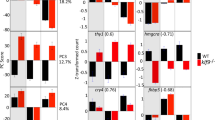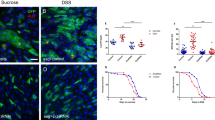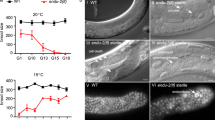Abstract
The coordination of stem- and blast-cell behaviours, such as self-renewal, differentiation and quiescence, with physiological changes underlies growth, regeneration and tissue homeostasis1,2,3. Germline stem and somatic blast cells in newly hatched Caenorhabditis elegans larvae can suspend postembryonic development, which consists of diverse cellular events such as migration, proliferation and differentiation, until the nutritional state becomes favourable (termed L1 diapause4,5,6). Although previous studies showed that the insulin/insulin-like growth factor (IGF) signalling (IIS) pathway regulates this developmental quiescence5,6,7,8, the detailed mechanism by which the IIS pathway enables these multipotent cells to respond to nutrient availability is unknown. Here we show in C. elegans that the microRNA (miRNA) miR-235, a sole orthologue of mammalian miR-92 from the oncogenic miR-17-92 cluster9,10, acts in the hypodermis and glial cells to arrest postembryonic developmental events in both neuroblasts and mesoblasts. Expression of mir-235 persists during L1 diapause, and decreases upon feeding in a manner dependent on the IIS pathway. Upregulation of one of the miR-235 targets, nhr-91, which encodes an orthologue of mammalian germ cell nuclear factor, is responsible for defects caused by loss of the miRNA. Our findings establish a novel role of a miR-92 orthologue in coupling blast-cell behaviours to the nutritional state.
This is a preview of subscription content, access via your institution
Access options
Subscribe to this journal
Receive 51 print issues and online access
$199.00 per year
only $3.90 per issue
Buy this article
- Purchase on Springer Link
- Instant access to full article PDF
Prices may be subject to local taxes which are calculated during checkout




Similar content being viewed by others
References
Jasper, H. & Jones, D. L. Metabolic regulation of stem cell behavior and implications for aging. Cell Metab. 12, 561–565 (2010)
Ables, E. T. & Drummond-Barbosa, D. Food for thought: neural stem cells on a diet. Cell Stem Cell 8, 352–354 (2011)
Nakada, D., Levi, B. P. & Morrison, S. J. Integrating physiological regulation with stem cell and tissue homeostasis. Neuron 70, 703–718 (2011)
Hong, Y., Roy, R. & Ambros, V. Developmental regulation of a cyclin-dependent kinase inhibitor controls postembryonic cell cycle progression in Caenorhabditis elegans. Development 125, 3585–3597 (1998)
Fukuyama, M., Rougvie, A. E. & Rothman, J. H. C. elegans DAF-18/PTEN mediates nutrient-dependent arrest of cell cycle and growth in the germline. Curr. Biol. 16, 773–779 (2006)
Baugh, L. R. & Sternberg, P. W. DAF-16/FOXO regulates transcription of cki-1/Cip/Kip and repression of lin-4 during C. elegans L1 arrest. Curr. Biol. 16, 780–785 (2006)
Gems, D. et al. Two pleiotropic classes of daf-2 mutation affect larval arrest, adult behavior, reproduction and longevity in Caenorhabditis elegans. Genetics 150, 129–155 (1998)
Kao, G. et al. ASNA-1 positively regulates insulin secretion in C. elegans and mammalian cells. Cell 128, 577–587 (2007)
Olive, V., Jiang, I. & He, L. mir-17-92, a cluster of miRNAs in the midst of the cancer network. Int. J. Biochem. Cell Biol. 42, 1348–1354 (2010)
Ibáñez-Ventoso, C., Vora, M. & Driscoll, M. Sequence relationships among C. elegans, D. melanogaster and human microRNAs highlight the extensive conservation of microRNAs in biology. PLoS ONE 3, e2818 (2008)
Bartel, D. P. MicroRNAs: target recognition and regulatory functions. Cell 136, 215–233 (2009)
Yi, R., Poy, M. N., Stoffel, M. & Fuchs, E. A skin microRNA promotes differentiation by repressing ‘stemness’. Nature 452, 225–229 (2008)
Lee, R. C., Feinbaum, R. L. & Ambros, V. The C. elegans heterochronic gene lin-4 encodes small RNAs with antisense complementarity to lin-14. Cell 75, 843–854 (1993)
Reinhart, B. J. et al. The 21-nucleotide let-7 RNA regulates developmental timing in Caenorhabditis elegans. Nature 403, 901–906 (2000)
Miska, E. A. et al. Most Caenorhabditis elegans microRNAs are individually not essential for development or viability. PLoS Genet. 3, 2395–2403 (2007)
Sulston, J. E. & Horvitz, H. R. Post-embryonic cell lineages of the nematode, Caenorhabditis elegans. Dev. Biol. 56, 110–156 (1977)
Meli, V. S., Osuna, B., Ruvkun, G. & Frand, A. R. MLT-10 defines a family of DUF644 and proline-rich repeat proteins involved in the molting cycle of Caenorhabditis elegans. Mol. Biol. Cell 21, 1648–1661 (2010)
Monsalve, G. C., Van Buskirk, C. & Frand, A. R. LIN-42/PERIOD controls cyclical and developmental progression of C. elegans molts. Curr. Biol. 21, 2033–2045 (2011)
Feinbaum, R. & Ambros, V. The timing of lin-4 RNA accumulation controls the timing of postembryonic developmental events in Caenorhabditis elegans. Dev. Biol. 210, 87–95 (1999)
Kimble, J. & Hirsh, D. The postembryonic cell lineages of the hermaphrodite and male gonads in Caenorhabditis elegans. Dev. Biol. 70, 396–417 (1979)
Fukuyama, M. et al. C. elegans AMPKs promote survival and arrest germline development during nutrient stress. Biol. Open 1, 929–936 (2012)
Furuyama, T. et al. Identification of the differential distribution patterns of mRNAs and consensus binding sequences for mouse DAF-16 homologues. Biochem. J. 349, 629–634 (2000)
Murphy, C. T. et al. Genes that act downstream of DAF-16 to influence the lifespan of Caenorhabditis elegans. Nature 424, 277–283 (2003)
Gissendanner, C. R., Crossgrove, K., Kraus, K. A., Maina, C. V. & Sluder, A. E. Expression and function of conserved nuclear receptor genes in Caenorhabditis elegans. Dev. Biol. 266, 399–416 (2004)
Fuhrmann, G. et al. Mouse germline restriction of Oct4 expression by germ cell nuclear factor. Dev. Cell 1, 377–387 (2001)
Akamatsu, W., DeVeale, B., Okano, H., Cooney, A. J. & van der Kooy, D. Suppression of Oct4 by germ cell nuclear factor restricts pluripotency and promotes neural stem cell development in the early neural lineage. J. Neurosci. 29, 2113–2124 (2009)
Yilmaz, O. H. et al. mTORC1 in the Paneth cell niche couples intestinal stem-cell function to calorie intake. Nature 486, 490–495 (2012)
Lewis, J. A. & Fleming, J. T. Basic culture methods. Methods Cell Biol. 48, 3–29 (1995)
Harfe, B. D. et al. Analysis of a Caenorhabditis elegans Twist homolog identifies conserved and divergent aspects of mesodermal patterning. Genes Dev. 12, 2623–2635 (1998)
Acknowledgements
We thank A. Fire, A. Frand, Y. Iino, S. Mitani, X. Wei and K. Shen for reagents and strains, and K. Iki for comments on the manuscript. Some C. elegans strains used in this study were provided by the Caenorhabditis Genetics Center, which is funded by the National Institutes of Health National Center for Research Resources, and the MITANI Lab through the National Bio-Resource Project of the Ministry of Education, Culture, Sports, Science and Technology (MEXT), Japan. This work was supported by Japan Society for the Promotion of Science KAKENHI grant numbers 23229001 (T.K.), 23370083 (K.K.), and MEXT KAKENHI grant numbers 24657081 (T.K.), 23116703 (M.F.).
Author information
Authors and Affiliations
Contributions
H.K., M.F. and A.K. designed and performed the experiments; all authors analysed and interpreted the data; M.F., K.K. and T.K. supervised the project; H.K. and M.F. wrote the manuscript with comments from all authors.
Corresponding author
Ethics declarations
Competing interests
The authors declare no competing financial interests.
Supplementary information
Supplementary Information
This file contains a Supplementary Discussion, Supplementary Methods, Supplementary Figures 1-12 and Supplementary References. (PDF 2880 kb)
Rights and permissions
About this article
Cite this article
Kasuga, H., Fukuyama, M., Kitazawa, A. et al. The microRNA miR-235 couples blast-cell quiescence to the nutritional state. Nature 497, 503–506 (2013). https://doi.org/10.1038/nature12117
Received:
Accepted:
Published:
Issue Date:
DOI: https://doi.org/10.1038/nature12117
This article is cited by
-
The C. elegans miR-235 regulates the toxicity of graphene oxide via targeting the nuclear hormone receptor DAF-12 in the intestine
Scientific Reports (2020)
-
Profiling microRNAs through development of the parasitic nematode Haemonchus identifies nematode-specific miRNAs that suppress larval development
Scientific Reports (2019)
Comments
By submitting a comment you agree to abide by our Terms and Community Guidelines. If you find something abusive or that does not comply with our terms or guidelines please flag it as inappropriate.



